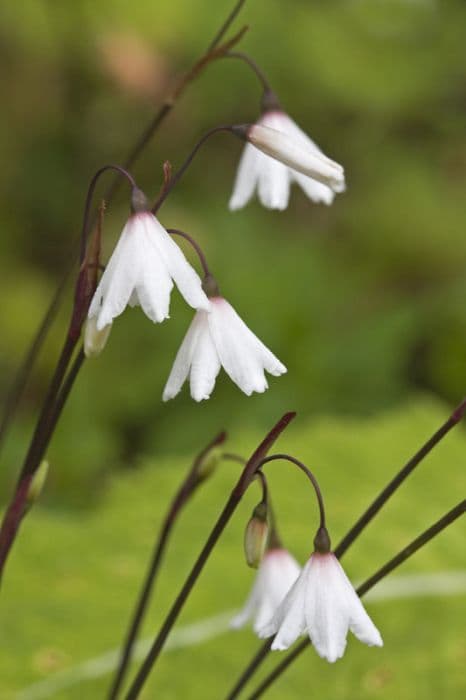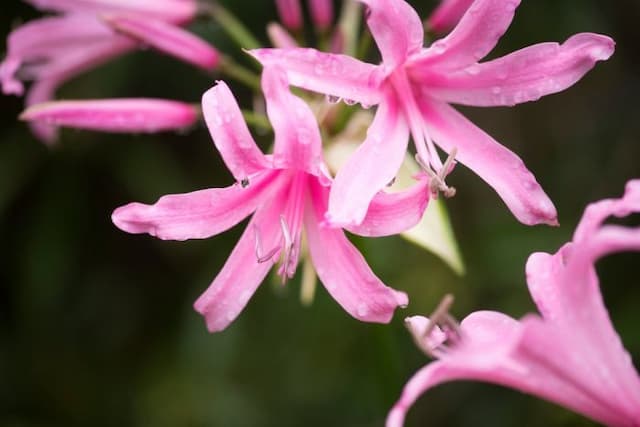Daffodil Narcissus 'Lowena' (4)

ABOUT
Narcissus 'Lowena' is commonly known as daffodil 'Lowena', and it features the quintessential characteristics associated with daffodils. The plant bears striking flowers, each with a central cup or corona that is surrounded by a ring of petals, often referred to as the perianth. In this particular variety, the trumpet-shaped corona is usually a different hue compared to the surrounding petals, creating a two-tone effect that can be quite eye-catching in a garden setting. The petals of daffodil 'Lowena' typically form a backdrop for the coronas, and they are arranged in a whorl, spreading elegantly from the base of the corona. These petals have a soft, smooth texture and are firm to the touch. The flowers themselves sit atop sturdy, upright stalks which emerge from clumps of linear, strap-like leaves. These leaves are a rich green color and have a slightly fleshy appearance, contributing to the overall lushness of the plant. The distinctive blooms of daffodil 'Lowena' are often associated with the arrival of spring as they are among the first flowers to bloom after the winter season. The color palette of the blooms can vary but typically involves soft pastel shades or vibrant yellows, providing a cheery display in gardens or when cut for floral arrangements. To sum up, daffodil 'Lowena' is characterized by its prominent, colorful flowers with contrasting coronas and petals, supported by straight stems, and accompanied by green, blade-like foliage. It is a plant that brings a lively burst of color to any setting, heralding the warmer days of spring.
About this plant
 Names
NamesSynonyms
Daffodil, Jonquil, Narcissus.
Common names
Narcissus 'Lowena'.
 Toxicity
ToxicityTo humans
The plant commonly known as daffodil, which includes the Narcissus 'Lowena', contains toxic alkaloids, primarily lycorine. If any part of the plant is ingested, the symptoms of poisoning can include nausea, vomiting, diarrhea, abdominal pain, and in some cases, severe symptoms like irregular heart rhythms and convulsions may occur. Nevertheless, significant ingestions are infrequent as the plant is known to be unpalatable, and serious outcomes are rare.
To pets
In pets, the daffodil, which the Narcissus 'Lowena' is a variety of, is considered toxic. The entire plant contains the alkaloid lycorine, but the bulbs are the most toxic part. If ingested, symptoms can include vomiting, salivation, diarrhea, low blood pressure, tremors, and cardiac arrhythmias. In severe cases, seizures and even death can occur, particularly if large quantities of the bulb are consumed. Pet owners should prevent their animals from having access to daffodils in gardens or as cut flowers indoors.
 Characteristics
CharacteristicsLife cycle
Perennials
Foliage type
Deciduous
Color of leaves
Green
Flower color
White
Height
1 feet 6 inches (45.72 cm)
Spread
1 feet (30.48 cm)
Plant type
Bulb
Hardiness zones
3
Native area
Europe
Benefits
 General Benefits
General Benefits- Aesthetic Appeal: Adds vibrant color and unique form to gardens or landscapes with its bright and striking flowers.
- Ease of Care: Requires minimal maintenance, making it suitable for both novice and experienced gardeners.
- Rodent and Deer Resistant: The plant is unattractive to rodents and deer, helping to protect the garden from unwanted visitors.
- Early Spring Blooming: One of the first plants to bloom in spring, offering an early splash of color after the winter months.
- Naturalizing: Has the ability to spread and create larger displays over the years, enhancing garden spaces without additional planting.
- Symbolic Significance: Often associated with new beginnings and rebirth, it can provide symbolic value in various cultural contexts.
- Attracts Pollinators: Welcomes bees and other pollinating insects to the garden, supporting local ecosystems.
- Cut Flower Use: Suitable as a cut flower, allowing the beauty of the plant to be brought indoors and enjoyed in floral arrangements.
 Medical Properties
Medical PropertiesThis plant is not used for medical purposes.
 Air-purifying Qualities
Air-purifying QualitiesThis plant is not specifically known for air purifying qualities.
 Other Uses
Other Uses- Narcissus 'Lowena' bulbs can be used to make a natural glue. The sticky substance found within the bulb has adhesive properties.
- The petals of narcissus can be pressed and included in artwork or bookmark designs for their aesthetic appeal.
- Dried narcissus flowers are sometimes used in potpourri mixes to add fragrance and beauty to a room.
- Narcissus flowers can act as natural pest repellents in gardens due to their strong scent which deters certain insects and animals.
- The plant's fibers can be utilized in traditional papermaking processes, providing texture and decoration to handmade paper.
- Narcissus 'Lowena' can be used in dye production, where the flowers provide a soft yellow hue to fabric or yarns.
- Some cultures use narcissus plants in ceremonies and rituals, symbolizing rebirth or new beginnings due to their spring bloom.
- The flowers serve as a nectar source for certain insects, playing a role in the local eco-system by supporting biodiversity.
- Narcissus can be integrated into educational activities, such as plant biology or botany studies, to learn about plant growth and reproduction.
- In floral language or floriography, narcissus can be used to convey messages, where they might symbolize self-love or vanity.
Interesting Facts
 Feng Shui
Feng ShuiThe daffodil is associated with good fortune in Feng Shui. It's believed to bring positive energy, particularly when placed in the north area of a home or room, which is connected to career and path in life.
 Zodiac Sign Compitability
Zodiac Sign CompitabilityThe daffodil is not used in astrology practice.
 Plant Symbolism
Plant Symbolism- Rebirth and New Beginnings: Narcissus blooms in the early spring, making them a symbol of the renewal and the arrival of a new season.
- Hope and Optimism: The bright, cheerful flowers of the daffodil represent hope and optimism, as they are among the first flowers to emerge after winter.
- Vanity and Self-absorption: Named after the Greek myth of Narcissus, the plant can signify excessive self-love and vanity, as Narcissus was known for his obsession with his own reflection.
- Prosperity and Wealth: In some cultures, especially in Chinese traditions, the Narcissus is associated with prosperity and wealth due to its golden hue and blooming around the time of the Chinese New Year.
 Water
WaterFor the daffodil Narcissus 'Lowena', water thoroughly whenever the top inch of soil feels dry to the touch, which often translates to once a week, depending on environmental conditions. During the growing season, it may require more frequent watering, especially if outdoors in warm, dry weather. Ensure the water penetrates the soil to reach the roots but avoid waterlogging the plant. Typically, using about one to two gallons of water per square yard every two weeks should suffice. Reduce watering after the blooming period and during dormancy.
 Light
LightDaffodils, including Narcissus 'Lowena', thrive in full to partial sunlight. Positioning them in a spot where they can receive at least six hours of direct sun a day is ideal. However, they can also tolerate light shade, especially in hotter climates where some protection from the intense afternoon sun can be beneficial.
 Temperature
TemperatureThe Narcissus 'Lowena' prefers moderate temperatures and will thrive best in conditions ranging between 50°F and 70°F. They can withstand winter temperatures down to about 20°F, but should be protected or brought indoors if colder weather is expected. During the active growing season, maintaining a consistent temperature within the ideal range will promote healthy growth.
 Pruning
PruningPrune daffodils like Narcissus 'Lowena' by deadheading spent flowers to encourage future blooms and maintain a tidy appearance. However, leave the foliage intact until it has yellowed and withered, usually six to eight weeks after flowering, as this helps the plant gather energy for the next season. Pruning by cleaning up dead foliage can be done annually, at the end of the blooming season.
 Cleaning
CleaningAs needed
 Soil
SoilThe ideal soil mix for Daffodil 'Lowena' should be well-draining with a slightly acidic to neutral pH of 6.0 to 7.0. A combination of loamy soil enriched with compost and some sand can create a suitable growing medium for this plant.
 Repotting
RepottingDaffodils, including the 'Lowena' variety, typically do not need frequent repotting. They should be repotted every 3 to 5 years, or when the bulbs become overcrowded in their current container.
 Humidity & Misting
Humidity & MistingDaffodils like 'Lowena' prefer average humidity levels. They can tolerate some amount of humidity variation, but they do best in outdoor conditions where the humidity is naturally regulated.
 Suitable locations
Suitable locationsIndoor
Place in bright, indirect light and keep soil moderately moist.
Outdoor
Plant in well-draining soil with full to partial sunlight.
Hardiness zone
3-9 USDA
 Life cycle
Life cycleNarcissus 'Lowena', commonly known as daffodil, begins its life cycle when a bulb is planted in well-drained soil in the fall before the first frost. In the spring, the bulb sends up green shoots, leaves, and a stem that produces a single flower, ranging in color from cream to bright yellow with a corona that is often a different shade. After flowering, the plant goes through a period of photosynthesis and energy storage, during which the foliage should be left intact to allow the bulb to gather energy for the next year. The leaves eventually yellow and die back as the plant enters dormancy during the summer months. The bulb remains dormant underground throughout the hot summer until cooler temperatures in the fall signal the beginning of the next growth cycle. Each bulb can produce offsets that may also grow into flowering plants, expanding the presence of Narcissus 'Lowena' in the garden over time.
 Propogation
PropogationPropogation time
Spring to Autumn
The Narcissus 'Lowena', commonly known as a daffodil, commonly undergoes propagation through a method called division. This process is typically done in late summer to fall, after the plant has finished blooming and the foliage has died back. Gardeners dig up the bulbs carefully, ensuring they do not damage the fleshy scales. Clumps of bulbs are gently separated by hand into individual bulbs, which include both mature bulbs and the smaller bulbils or offsets that form at the base of the parent bulb. Each separated bulb can then be replanted into well-draining soil at a depth of about 6 inches (approximately 15 centimeters). Replanting should be spaced about 3 to 6 inches (7.6 to 15.2 centimeters) apart to provide space for growth. This method encourages natural clonal propagation and helps to rejuvenate over-crowded plantings, ensuring vigorous growth and blooming in the following spring.









